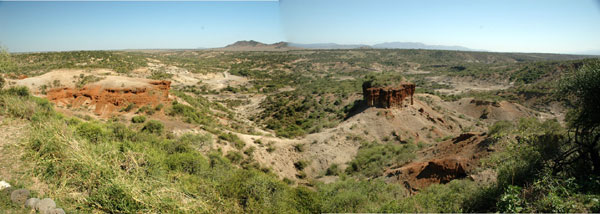Evolution of Hominids in Africa
In addition to volcanic rocks, which we will talk about later in the course, the African Rift is home to a diversity of fossils that have shaped our collective knowledge about human origins. To many, the African Rift Valley is best known as the likely area where "man" evolved from "apes." We have used quotation marks around these words because they are defined subjectively even among scientists. In general terms, man refers to a bipedal savanna-dweller who could use tools and language to their own advantage. Ape, in contrast, refers to a four-legged animal who lives primarily in trees and uses only opportunistic tools rather than creating their own. It must be emphasized that the links between man and ape are complex and cannot be drawn with certainty, but the overall evolutionary path is well documented by the fossil record. Our present understanding of our ancestral species is incomplete, and new finds will spark new debates over the coming years.
Video: View a short 5-minute video clip that discusses the significant early hominid fossil finds in Ethiopia, including the famous "Lucy" skeleton.
The African Rift is an excellent site for species to have developed and diversified for many reasons. It marks the border between tropical rain forest and savanna ecosystems, the former still home to gorillas and chimpanzees and the latter the home of many communal monkey species. It plays an important role as a catch-basin for rainfall in an arid environment. It experienced tremendous climate change during the past 6 million years (climate change is often an agent for species change).

Olduvai Gorge. Source: Shunya's Site. © 2005 Shunya.
These factors make the rift an excellent location to search for ancestral hominids, and indeed most of our knowledge of human evolution comes from a small number of well-studied localities throughout the rift system.
If you haven't already, read A Changing Climate for Human Evolution (Geotimes, 2005) to learn more about the environmental changes that have occurred in East Africa and the potential impact on humans walking upright and developing bigger brains.
Dr. Alan Walker
Penn State is fortunate to have Dr. Alan Walker, Professor of Anthropology and Biology, on its faculty. Dr. Walker is a paleoanthropologist who works on primate and human evolution, concentrating mainly on the Neogene record from East Africa. He lived and worked in Africa before coming to the U.S. in 1973, where he taught at Harvard (1973–8) and Johns Hopkins (1978-1997) before coming to Penn State. Dr. Walker has conducted extensive field research on the evolutionary implications of Kenyan fossils. His discoveries include a 1·6-million-year-old Homo erectus (1984) and a 2·5-million-year-old ‘hyper-robust’ Australopithecus boisei (1985). (Biography.com, 2 February, 2006.)
Below you will find three video clips. The first offers an introduction to Dr. Walker. In the remaining clips, Dr. Walker address the key questions: Why look for fossils in Africa? and What's left to look for in Africa?
As you can see, the origins of humans is quite complex. Scientists must examine not just the fossil bones and anatomical changes through time, but changes in the environment must be studied to place human evolution in context. What we have learned about the past 8 million years of the origins of humankind is summarized with a timeline and photos on the PBS-Evolution Web site. This site is a *must* to learn about our ancestors such as Homo habilis and Australopithecus anamensis.
Videos:
One of the significant locality finds is the Laetoli trackway. Check out this 3-minute video clip that highlights the first trail of early hominid footprints.
Curious about the anatomical differences between humans and chimps, and what allows us to walk upright? View this 1-minute video clip that explains the strengths and weaknesses of walking upright versus being a knuckle-walker.